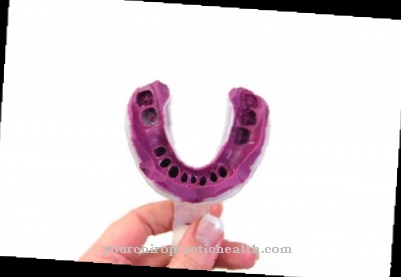At the Larynx mirror, which is also called Laryngoscope is known, it is a simply constructed device for the optical examination of the larynx.
What is the larynx mirror?

It consists of a small, round mirror and a long, thin metal handle. Since the actual mirror has a certain inclination towards the handle, the larynx and the rest of the mouth and throat area can be viewed with such a larynx mirror without great effort. In addition, only one light source is required for such an examination.
The laryngoscope was invented as early as 1743 and originally only served to visualize the vocal fold function, for example when singing and speaking. This contributed a lot to the anatomical understanding of the voice.
Shapes, types & types
The principle of the larynx mirror is always the same. It's a small mirror attached to a long handle at a specific angle. The diameter of the mirror can have different sizes. Such a larynx mirror is also available for private use for a few euros.
For an indirect laryngoscopy, in addition to a simple larynx mirror, other instruments for viewing the larynx can also be used. These are endoscopes such as an inclined magnifying endoscope or a fiber-optic endoscope made of flexible material. This is also suitable for patients with strong gag reflex or little mobility in the jaw.
For a direct view of the larynx as part of a more detailed medical examination, other laryngoscopes are required. The so-called surgical laryngoscope, on the other hand, is mainly used for medical interventions on the larynx. It has a tubular structure, has integrated lighting and enables an optimal view of the larynx. A laryngoscope is also used for intubation. The intubation laryngoscope has a spatula-shaped design and is part of the standard equipment in every operating room.
Structure & functionality
In a conventional hand-held larynx mirror, the actual plane mirror is located at an angle of around 45 degrees at the end of a long, thin metal shaft. The mirror is available in different sizes and usually with a diameter of 1.5 to 3 cm, about the size of a euro coin. The length of the mostly metal handle is between 15 and 20 cm. With this length the optimal position in the throat for examining the larynx is easy to reach.
Since the larynx mirror itself does not contain any lighting, the doctor has to supply a light source indirectly from outside, for example via a headlamp or a forehead mirror. The light beam is deflected onto the patient's larynx via the larynx mirror so that the doctor can see something there.
A larynx mirror enables an indirect view of the larynx, through which some basic functions of the larynx - for example the closure of the vocal folds or the integrity after injuries - can be examined. Viewing the larynx with a larynx mirror, however, is the simplest form of examination. For more complicated interventions or a more precise examination, more complex devices exist for the same purpose.
Essential for the function of the larynx mirror is the special inclination of the actual mirror at a relatively large angle to the handle as well as one of the best-known physical rules of reflection: the angle of incidence of the image - in this case the larynx - corresponds to the angle of reflection - in this case what the doctor recognizes in the mirror.
You can find your medication here
➔ Medicines for hoarsenessMedical & health benefits
With the help of a larynx mirror, the larynx can be viewed and its function and anatomy can be inspected.ENT doctors or - especially in the case of severe vocal problems as well as singers and similar professional groups whose potential is their own voice - also specialized phoniatrists are the right place to go.
The phenomena examined with a larynx mirror include, for example, the closure of the vocal folds, which singers and similar professional groups in particular with high vocal stress often want or need to have checked. While an indirect viewing of the larynx, for example through the larynx mirror, takes place without anesthesia, the patient is always anesthetized with more complex devices when viewing the larynx directly.
Reasons for a larynxoscopy are symptoms that suggest a functional or anatomical disorder of the larynx. These include general speech and swallowing problems, long-lasting hoarseness or irritable coughs, as well as annoying noises such as a low whistle when breathing.
Singers are often afraid of nodules on the vocal cords. For smokers, on the other hand, a larynxoscopy can be particularly useful in order to identify larynx cancer as early as possible and treat it accordingly. In the case of injuries in the area of the larynx, this must also be carefully inspected.
Not only ENT doctors, but also emergency doctors will always have a larynx mirror with them, as it is also needed in the event of intubation. For the same reason, a laryngoscope is one of the everyday instruments in the operating room.



























